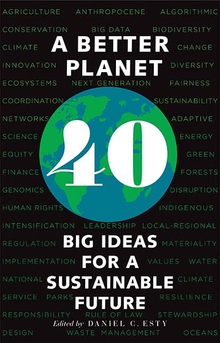Nine Steps to a Sustainable Future
In our new book A Better Planet, leading environmentalists present long-term solutions for a sustainable future amid our ecological crisis. The forty essays advocate a bipartisan program and cover topics like forestry, agriculture, data, public health, natural disasters, and city planning. We’ve selected excerpts from nine of the essays that reflect the research-based, actionable approach that characterizes the whole book.
Mark S. Ashton and Craig R. Brodersen—
Restoration of these forests requires changes in building codes and zoning laws, the creation of strong markets for carbon sequestration and watershed protection, and a governance structure that allows managers to manage with greater, more site-specific creativity. The forests themselves, because of overstocking, need judicious thinning in places to accelerate their development from stem exclusion to understory initiation. Managers also need to reintroduce fire back into the landscape both through purposeful prescribed burning and by allowing nature to self-regulate in more remote areas through natural origin wildfires. At a larger scale, the forests need to regenerate over time and space at scales defined by historical records of natural disturbance size, frequency, and severity.
Larry Selzer—
The nature of land conservation in America needs to change. Up until this point, we largely have trusted governments to conserve land in its natural state to protect biodiversity and the landscapes we love. In the future, however, if we are to conserve the vast important landscapes needed to protect biodiversity and water quality and become more resilient to climate change, land conservation is likely to focus less on fee ownership by public agencies and more on conservation easements on the lands that lie between our national parks and wildlife refuges—in other words, private lands.
Erin Fitzgerald and Greg Gershuny—
Five pathways, in particular, will be critical for a more sustainable future:
- Collaboration: Encourage farmers, agricultural experts, researchers, and investors to collaborate with the food value chain to find shared solutions to the full spectrum of environmental and social challenges—and create much needed research on sustainable food systems.
- Emphasis on nutrition: Ensure that agriculture meets the nutritional needs of a diverse and growing population. Plant and animal agriculture play important and complementary roles, not only in human health but also in supporting cultural, social, and economic wellbeing and enjoyment, improving our quality of life.
- Focus on reducing food waste: Food should always be put to its best use, which means we must reduce the amount of food wasted every year. Encouraging consumption patterns focused on lifestyles, including not taking or buying too much, and reducing food waste and food loss across the value chain from farm to consumer can have a large impact on sustainable food consumption.
- Technology innovation: Investments should be focused on enabling mitigation and adaptation to natural resource constraints while improving production efficiencies for yield and quality, including nutrient content, food safety, environmental outcomes, and resistance to pestilence and climate shocks. These investments should not underestimate the place-based complexity of solutions for farmers. Further, advancements in economic modeling to look at return on investment for both production and environmental services would provide valuable insights for farmers and policymakers.
- Carbon sequestration as a solution: Collaboration across our food systems and an outcome-based approach should elevate the ability for agriculture to create climate smart solutions and provide vital ecosystem services in the emerging Anthropocene era characterized by human impacts on the planet. Current trajectories predict the ability for U.S. agriculture’s soil to continue to improve and store more carbon. With the right policies and practices in place, agriculture has the potential to completely offset its greenhouse gas emissions and sequester carbon.
Jane Lubchenco—
Fishery reform and Fully and Highly Protected MPAs are proven tools to yield big economic, social, and environmental benefits. Both have huge potential to achieve much more than is currently being realized. And they can be used in tandem to achieve even greater benefits. Moreover, both can help provide insurance against other serious problems such as the effects of climate change and ocean acidification. Neither is being deployed at the scale needed for restoring ocean health, but they could be by removing barriers to that scaling.
Monica Medina—
Today, the modern National Weather Service has as its mission to “provide weather, water, and climate data, forecasts and warnings for the protection of life and property and enhancement of the national economy.” According to the United Nations, even under the best-case scenario, “limiting global warming to 1.5°C would require ‘rapid and far-reaching’ transitions in land, energy, industry, buildings, transport, and cities.” As part of such transitions, it is again time to upgrade our weather, warning, and watch systems in the United States in order to best adapt to the dangers that lie ahead due to the changing global climate.
Courtney Durham—
The era of certain uncertainty ushered in by climate change requires disaster preparedness unlike that seen before. We can equitably and sustainably build resilience to climate change impacts only when we include local communities and address root causes of vulnerability. Resources channeled toward preparation will save money in the long run, upward of fourfold. A new era of disaster risk reduction depends on planning with real-time data, along with continually improved monitoring and evaluation of disaster readiness efforts. Beyond the clear financial savings and technical advancements that make this new approach smarter, we have a moral imperative to help those experiencing very real climate change impacts today.
Karen C. Seto—
Urban and land use planning and multipronged land-based strategies must form part of the solution. Infrastructure and urban form are strongly linked and affect urban transport and building greenhouse gas emissions. Thus, to reduce urban greenhouse gas emissions, urban areas should invest in a combination of public transit, a higher mix of land uses, mobility demand management strategies, and co-locating people near jobs. A key principle is to increase accessibility, a concept that combines proximity and travel time. Accessibility means providing people with access to places, or destinations and origins, whether these are jobs, housing, services, shopping, or recreation. Increasing accessibility can substantively reduce green house gas emissions. Additionally, designing more compact and walkable cities—concepts related to accessibility—can also reduce urban sprawl and save land for nature, be it farmland or habitat. Walkable and accessible cities are a vital component of sustainable urbanization.
Alexander J. Felson—
Urban environments, projected to be home to two thirds of the global population by 2050, will continue to place additional demands on the aging and often failing city infrastructure systems, as well as on the green spaces that support cities and people. Twenty-first century city parks must be designed to absorb these added pressures while also addressing current health challenges and issues stemming from factors including urban heat islands, stormwater management, and habitat loss. To address this demand, we need to view urban green space as a high priority area of investment, a primary driver of urban redevelopment, and a critical asset for facilitating climate change adaptation. With a growing awareness of the value of having humans live in more nature-like environments, we need to reconceptualize twenty-first century park systems as extensive and fundamental components of the city fabric to be integrated at multiple scales into every aspect of urban land use.
William Nordhaus—
Unlike many other global externalities, climate change has a simple solution: make people pay for the harm they cause. For any policy to be effective, it must raise the market price of carbon dioxide and other greenhouse gas emissions. Putting a price on emissions corrects for the underpricing of the externality in the marketplace.
Prices can be raised by putting a regulatory tradable limit on the amount of allowable emissions (“cap and trade”) or by levying a tax on carbon emissions (a “carbon tax”). Both of these price signals would create incentives for changed behavior. A central lesson of economic history is the power of incentives. To slow climate change, everyone must have an incentive to replace their current fossil-fuel-driven consumption with low-carbon activities—millions of firms and billions of people spending trillions of dollars. The most effective incentive for change is a high price for carbon.
From A Better Planet edited by Daniel C. Esty. Published by Yale University Press in 2019. Reproduced with permission.
Daniel C. Esty is Hillhouse Professor of Environmental Law and Policy at Yale’s School of Forestry & Environmental Studies and Yale Law School. He served as head of the Connecticut Department of Energy and Environmental Protection from 2011 to 2014 and in several leadership roles at the U.S. Environmental Protection Agency from 1989 to 1993.
Further Reading:



























